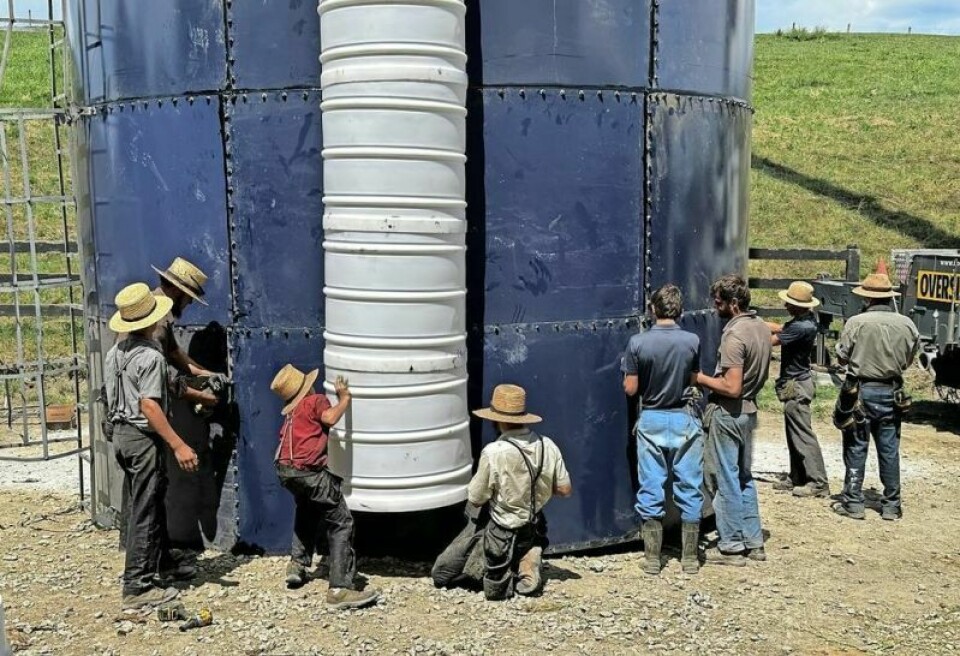Unique silo addition takes place in Walnut Creek

Over the years there have been many recorded examples of Amish barn raisings throughout Ohio’s Amish Country, where the Amish community unites to raise a barn for one of their neighboring families in one day.
It is truly a spectacle to behold.
However, on Tuesday, Aug. 13, a different raising took place near Walnut Creek in Hochstetler Valley, that being the raising of a silo.
The silo project took place on the family farm of John and Miriam Hershberger, with their son Brent and his family now living on the farm.
The original steel silo was built three decades ago, a 17-by-50-foot silo that had done its job, but the farm had since grown much too large and productive for that silo to store all the corn silage that was being grown and harvested.
The family was filling the silo and storing additional silage in bag silos next to it, which became a time-consuming effort. Thus Brent Hershberger was ready to find a better way.
That better way was having a company come in to raise the silo another 30 feet.
“They never used a crane when they originally built this silo,” John Hershberger said.
Hershberger said the 163-acre farm has been in his wife’s family since 1934, and they are eager to keep it in the family so they can eventually see it become a century farm.
The family turned to Jonas Esh, owner of Esh Silo from Lancaster County, Pennsylvania, and after many years, Esh and his team of two sons Steven, 14, and James, 12, and employee Andrew Zook know exactly how to make that happen.
The team left from Lancaster County in the early morning hours and immediately went to work, taking out the rivets of the current silo at about 10 feet high. They had the help of an enormous crane from Bogner Construction in Wooster, which attached its crane to the top of the silo and hoisted the remaining 40 feet into the air and off to the side of the two remaining sections.
Esh was joined by his team, along with both Hershberger men and a handful of neighbors and friends who helped place large sections of each 5-foot layer of steel silo together.
While it might seem likely to build the silo by simply adding to the top, working that high up would take far too long and be far too dangerous, so the upper 40-foot section of the silo hung several feet off the ground as the team worked quickly, riveting each 5-foot section together one layer at a time.
Members worked both inside and outside, crafting each section together until all six 5-foot layers had been pieced together, greased and rivets in place, and soon the additional 30 feet of silo was attached to the hanging 40 feet of original silo.
With the additions in place, it was now time to gently drop the 70 feet of silo on the crane into the 10 feet of original silo on the ground beside the barn.
Prior to that, the team had to place the unloader into the silo, a piece of equipment that will push the silage down as it is unloaded. That in itself was a precision job that came easily to the Esh team.
“It’s remarkable to watch them work,” John Hershberger said. “There’s a lot of precision in everything they do. They definitely know what they’re doing.”
The raising drew admirers from throughout the area who watched the silo project take place.
It was incredible to watch the precision with which the crane operator followed Esh’s instructions as he placed the 70 feet of silo on top.
The entire process was a smooth operation, and soon the entire crew was busy riveting the 70 feet of silo onto the 10 feet on the ground.
Zook then crawled to the top of the silo, unhooking the crane from the silo. He then perched himself in the caged ladder and began riveting the loading chute next to the ladder in an effort that would make many queasy at that height.
Raising an 80-foot silo is not for the feint of heart.
From below Esh continued to manage the operation, and by 5 p.m. the entire process was complete.
“It’s not easy work, but it is very satisfying work,” Esh said. “A daylong effort like this wears you out, but we had some great help from some of the friends and neighbors.”
The newly altered silo had gone from 50 feet high to 80 feet high, but in the process, because of compaction, it now will hold more than double of what it would have contained previously.
The silo will now hold 400 tons of corn silage, and the ease with which the family can store and retrieve the silage will make the process much easier and affordable.
“This is going to benefit the family so much,” Esh said of the additional 30 feet of silo.
The entire Esh crew would spend the evening on the Hershberger farm before heading off the next morning to the job in Sugarcreek.
























